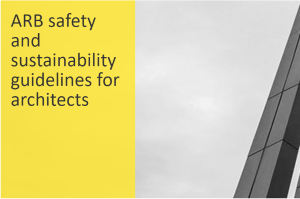 The Architects Registration Board (ARB) has published new guidelines for all architects on Fire and life safety design and Sustainability.
The Architects Registration Board (ARB) has published new guidelines for all architects on Fire and life safety design and Sustainability.
… guidelines also promote the need for architects to understand their role…. [and to]… manage risk on a building project…
… Do everything within their remit to minimise their negative impact on the environment…
The Architect’s Registration Board (ARB) writes:
Competent fire and life safety design is of central importance to the services architects offer. After the Grenfell Tower tragedy, Dame Judith Hackitt’s Review ‘Building a Safer Future’ recommended that ARB should address fire safety in design as part of the competence levels required of architects. Anyone engaging an architect should expect them to be fully competent in their knowledge on this key area, regardless of the size or scale of the project. All registered architects should ensure the health and safety of the people who use buildings outweighs any other obligations they may have. The guidelines also promote the need for architects to understand their role within a design team, and for them to know how to manage risk on a building project.
According to figures from the United Nations Environment Global Status Report in 2017, construction and building account for more than 35% of global energy use and almost 40% of energy-related CO2 emissions; an improvement on the 2010 figures, but there is still further to go. The climate emergency the world is facing has led ARB to develop guidelines for all registered architects to ensure they are fully competent in all areas of sustainability that apply to buildings and all areas of architecture.
Architects themselves support the need for these competencies; in a survey ARB commissioned in autumn 2020, architects reported that safety and sustainability were the two most common issues that had become more important to their job in the last five years.
The Fire and Life Safety guidelines state that architects should:
- Be able to design, detail and specify in a way that protects users of buildings and the public from fire and the spread of smoke
- Be able to design buildings with appropriately safe means of escape
- Be able to design appropriate access to buildings and facilities for emergency services
- Understand the qualities of specified materials in respect of fire performance, and how they perform as part of a construction system
- Be able to design to protect building users from hazards and risks during construction, use and maintenance.
The Sustainability guidelines state that architects should:
- Understand the principles of climate science in order to make informed and responsible decisions
- Do everything within their remit to minimise their negative impact on the environment
- Advocate for sustainable or regenerative design solutions
- Maintain their knowledge about key legislation and regulations in this area
- Share building performance data to raise industry awareness and encourage the industry to work towards a zero-carbon culture…..

